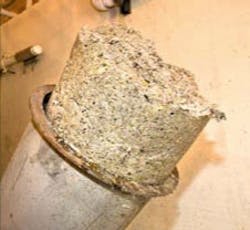Grinders Cut Costs at Minnesota Treatment Plant
In the beautiful town of Hutchinson, Minn., operators at the wastewater treatment facility have called upon four Monsters in recent years to tame a rising tide of trash and rags in their plant.
In 2005, plant officials tackled a problem area in the influent pump station where twin 20-year-old bar screens were in need of constant maintenance.
“Maintenance alone on those bar screens was huge,” said Troy Heimerl of Electric Pump, a local systems integrator called in to look for solutions. “It was kind of sloppy and the lift station was next to a baseball park, so there were occasional odors from the screenings.”
The small particles flow easily through four 150-hp influent pumps, and with the Channel Monsters, the pumps never clog, according to Mies. Screenings are sent to the treatment plant instead of getting screened out inside the station, so the baseball field is always a pleasant place to play.
Eric Meester, P.E., a consulting engineer on the project based at Donohue and Associates’ Minneapolis office, said he carefully researched grinders and decided they are a clean, low-maintenance way to protect pumps.
“We had some concerns about sending more material into the plant headworks,” Meester said. “But everyone seems extremely happy and it worked out better than expected. I would absolutely look at grinding at remote pump stations, but you have to have fine screens [in the headworks].”
The Hutchinson treatment facility receives nearly 4 million gal per day. The town of 13,000 is surrounded by several lakes and is a mix of residential, commercial and light manufacturing.
The next problem the city tackled was a room full of static influent screens in the headworks. Pumps lift wastewater to the top of curved, stationary screens covered with slots. Wastewater pours through the slots while solids slide to the bottom, where an auger conveys them to a dumpster. Screenings, soft organics and water plop into a dewatering dumpster to dry out.
“We had nothing to clean the screenings,” Mies said. “It was just a ton of stuff, about 14 yards per week. We had a drainage area and as screenings built up, they got heavy and it squeezes out lots of water.”
To remedy the screenings problem, the city and consulting engineer Donohue and Associates called on the Screenings Washer Monster (SWM), also from JWC. The SWM puts screenings through grinding, washing, dewatering and compacting in order to remove soft organics, thoroughly compact the material and remove more water.
“[The SWM] is doing a good job,” Mies said. “We don’t have any standing water in our screenings bin anymore.”
The city benefits from the SWM’s ability to tightly compact screenings—the number of dumpsters trucked to the landfill dropped 80% from 14 yards per week down to three. Today two dumpsters last the week instead of filling two dumpers per day. It adds up to big fiscal savings for the city in trucking and landfill fees.
“When we saw the demo SWM operate it was an instant sell,” said Meester. “It took the screenings, ground them up and cleaned out all the soft organics. [The SWM] made a huge difference inside the headworks room. The managers and operators keep the plant extremely clean, and the cleaner headworks is a big success.”
In 2008, plant managers called in one final Monster, another SWM to help with a membrane bioreactor (MBR) expansion. A pair of pump-fed drumscreens with tiny openings remove tons of fecal matter, bits of trash and hair and convey the material to the SWM’s hungry jaws, where it separates out liquid organics and compacts the trash.
The patented SWM is the only washer-compactor to incorporate a grinder that helps break open clumps of rags wrapped around soft organics so the internal spray wash system can liquefy organics and return them to the treatment flow. The grinder also shreds trash and rags into smaller particles so they more tightly compact together – allowing for a big reduction in screenings volume and trips to the landfill. Originally constructed in 1988, Hutchinson’s wastewater treatment facility went through a major upgrade designed by Donohue and Associates in 2008 to incorporate MBR technology. The flow is split after the headworks—most goes into an oxidation ditch, one of the largest in the Midwest, and then to a final clarifier. The rest of the flow is sent to the new MBR.
Before clean effluent is discharged into the South Fork of the Crow River, it is disinfected by a UV system, which eliminates any remaining bacteria. Hutchinson also operates an award-winning biosolids program that turns class-A biosolids into fertilizer for farms, golf courses and other uses.
